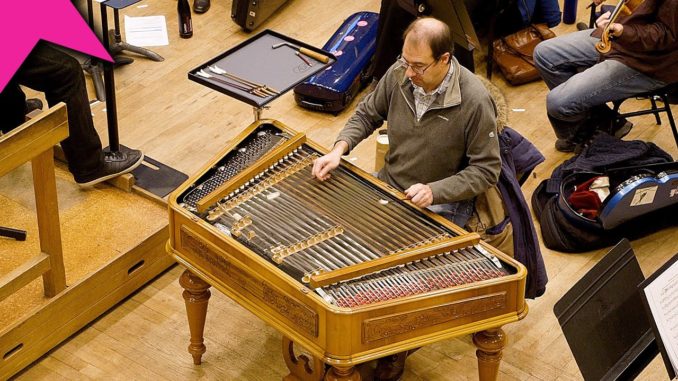
With its bright, shimmering tones and unique sound, the cimbalom is a musical instrument that has captivated musicians and audiences around the world. Originally a folk instrument from central and eastern Europe, the cimbalom has found its way into a variety of musical genres, from classical to pop music. In this article, we will take a closer look at the cimbalom, its history, construction, and musical applications. Whether you are a music lover or a curious listener, this article will give you a deeper appreciation for this fascinating instrument and the beautiful music it produces.

What is a Cimbalom?
The cimbalom is a musical instrument that originated in central and eastern Europe. The cimbalom, also known as cimbal or concert cimbalom, is a chordophone characterized by a sizeable trapezoidal box supported by legs. It features metal strings positioned on top, with a damping pedal situated underneath for control. This unique instrument combines shape and strings to produce its distinctive sounds.
It is a type of hammered dulcimer and is played by striking metal strings with hammers, which are often wrapped in felt to create a softer sound. The cimbalom is known for its bright, resonant tone, and its ability to produce a wide range of pitches and timbres. It has been used in a variety of musical genres, including folk, classical, and popular music.
The history of the cimbalom can be traced back to the 14th century, when it was known as the “tsymbaly” in Ukraine and other parts of eastern Europe. The instrument was primarily used in folk music and was often played at weddings and other festive occasions. Over time, the cimbalom began to be used in more formal settings, such as orchestras and concert halls. In the 19th century, the instrument underwent significant changes, with the addition of a damper pedal and other innovations that allowed for greater dynamic control and expressive range.
Today, the cimbalom is widely used in many different musical styles, from traditional folk music to contemporary classical music and jazz. It is particularly popular in Hungary, where it is often played in traditional ensembles alongside other folk instruments such as the violin, viola, and double bass. In recent years, the cimbalom has also gained popularity in other parts of the world, including the United States and Japan.
The construction of the cimbalom is complex, and the instrument requires a high degree of skill to play effectively. The body of the instrument is typically made of wood and is shaped like a trapezoid or a rectangle. The strings are stretched across the body of the instrument and are tuned to different pitches using tuning pins. The hammers used to strike the strings are also an important component of the instrument and are typically made of wood or metal.
What does the cimbalom sound like?
The cimbalom has a unique sound that is difficult to replicate with other instruments. Its bright, shimmering tone is often used to create a sense of excitement and energy in music, while its soft, muted tones can be used to create a sense of intimacy and warmth. The instrument is also capable of producing a wide range of dynamics, from whisper-soft to thunderous, and can be used to create complex rhythmic patterns and melodic lines.
One of the most famous composers to use the cimbalom in his music was the Hungarian composer Béla Bartók. Bartók was a pioneer of modern classical music and was known for his innovative use of folk music and traditional instruments in his compositions. He used the cimbalom extensively in his music, particularly in his “Concerto for Orchestra,” which features a prominent cimbalom solo in the final movement.
In addition to classical music, the cimbalom has also been used in a variety of popular music genres. In the 1960s and 70s, the instrument was popularized in the United States by the rock band The Doors, who used the cimbalom in their hit song “Touch Me.” The cimbalom has also been used in contemporary pop music, particularly in Eastern Europe and Russia, where it is often played in folk-influenced bands and ensembles.
How is a Cimbalom played?
The player of the cimbalom sits in front of the instrument, with the strings facing upward. The cimbalom usually rests on a stand or a table, which can be adjusted to the player’s height. The player uses two beaters, one in each hand, to strike the strings.
The strings of the cimbalom are arranged in groups of four, with each group tuned to the same pitch. The player can play chords by striking all the strings in a particular group at the same time, or they can play melodies by striking individual strings or groups of strings.
The cimbalom also has a pedal mechanism that can be used to dampen or sustain the sound of the strings. By pressing down on a pedal with their foot, the player can shorten the length of the strings and produce a staccato or muted effect, or they can release the pedal to allow the strings to vibrate freely and produce a sustained sound.
Overall, the cimbalom is a fascinating and unique instrument with a rich history and a wide range of musical applications. Its distinctive sound and expressive capabilities have made it a favorite of composers and musicians around the world, and its popularity shows no signs of waning. Whether you are a fan of folk music, classical music, or contemporary popular music, the cimbalom is a truly remarkable instrument that is sure to captivate and delight.
